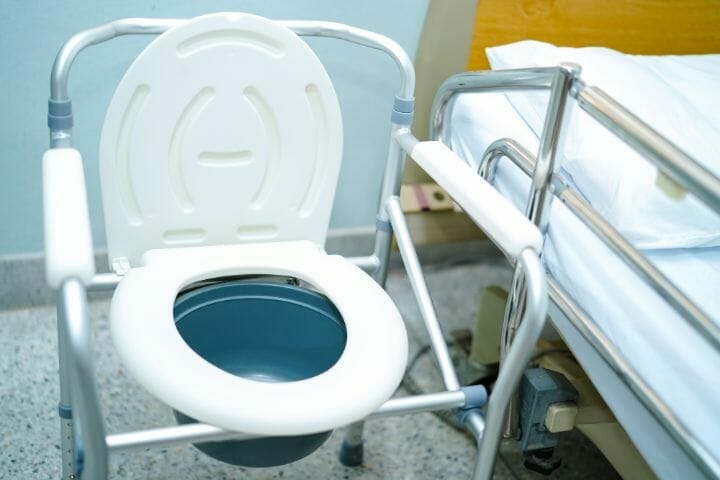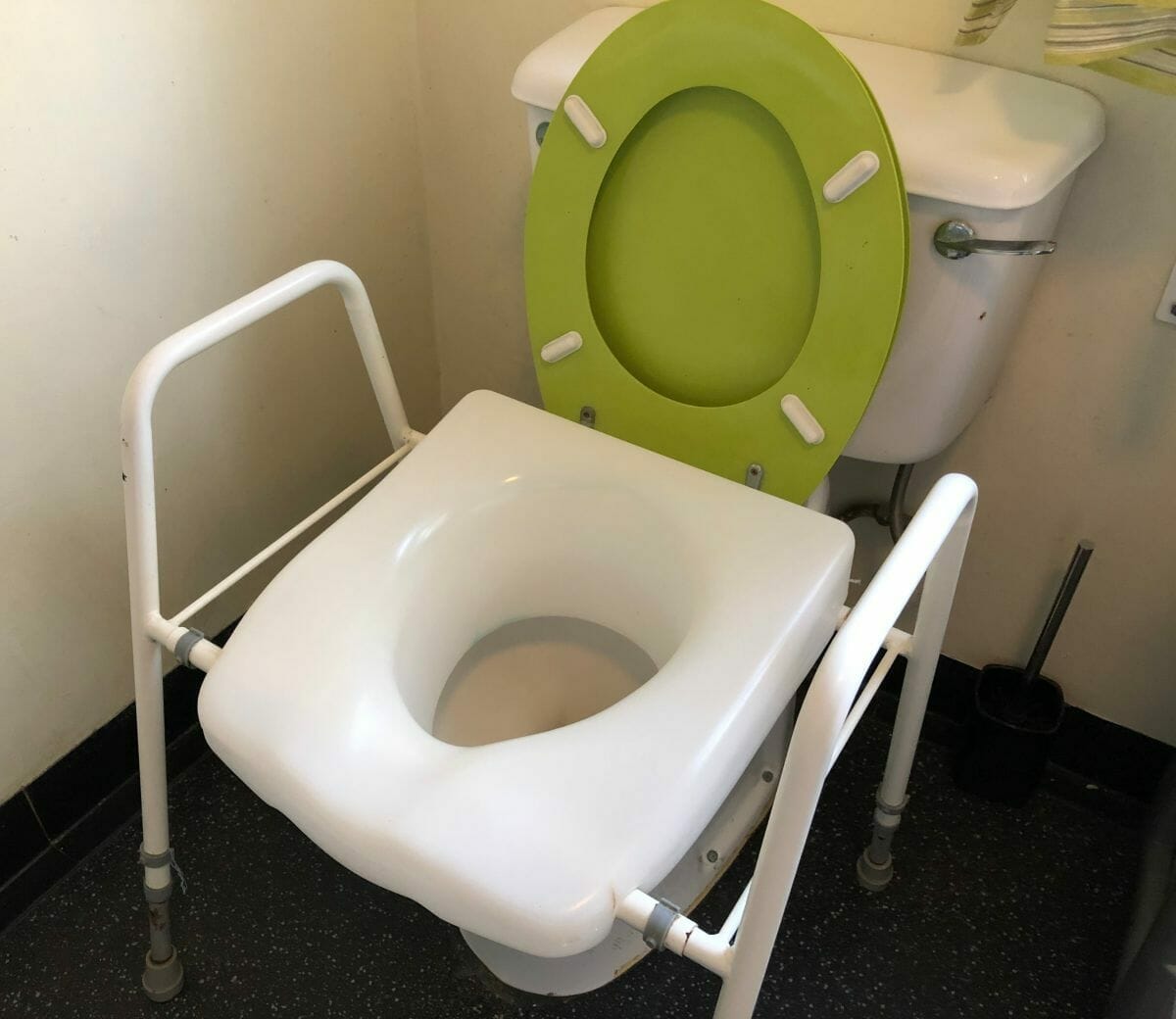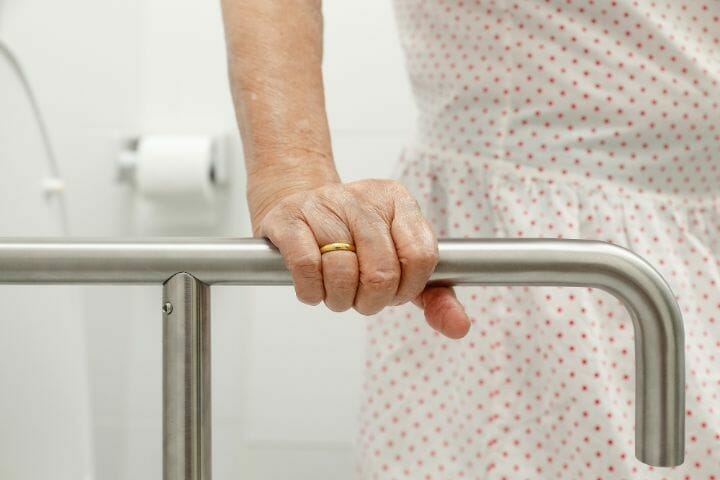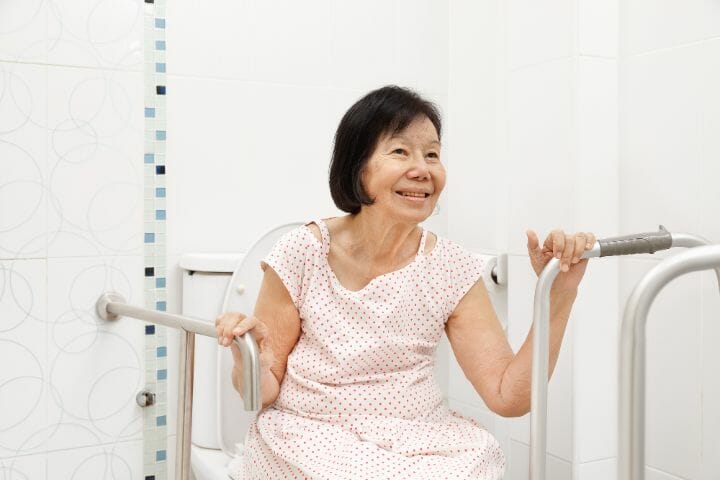How long do you have to use a raised toilet seat after a hip replacement? The answer in most cases is up to 6 to 10 weeks depending on a reevaluation from your physician you will be recommended to use a raised toilet seat after hip replacement.
But sometimes, it can take longer for elderly patients who are frail or find it difficult to use the toilet due to pain, their weight-bearing status, or their strength.
What is a Raised Toilet Anyway?
A standard toilet is 14 and a half inches from the floor to the bowl rim. On the other hand, raised toilets (or tall toilets) are 17 to 19 inches from the floor to the bowl rim. It is ideal for the elderly who have difficulty sitting down or getting up, and those who have undergone surgery like hip or knee replacement.
An increase in the toilet height can be temporary or permanent. If you are looking for a temporary solution, a toilet seat riser is your best option. It is an additional seat that raises the height of the toilet by three to five inches.
But if you are looking for a more permanent option, you can go for a tall toilet. In this case, you will be essentially replacing your existing toilet with a taller one. Please factor in the cost of installation as well when making this decision.
Another solution to toileting after hip replacement can be diapers for bedridden patients. Unlike a raised toilet seat or a tall toilet, adult diapers are a recurring cost and many adults might not be very comfortable wearing a diaper at their age.
Finally, you can also consider a bedside commode for after hip replacement. Decreasing the distance between your bed and the toilet can make a world of difference for people with limited strength or mobility, and even restore their full independence.

Contents
But Why is it Important to Use a Raised Toilet Seat?
After surgery, precautions and limitations of movement are imposed by your surgeon to give the hip the ability to heal. Also, the muscles of the operated leg will definitely weaken after a few days of limited mobility from the surgery.
Therefore, it is important to use a raised toilet seat or a tall toilet so that getting on and off the seat is easy when you need to relieve yourself.
Getting a raised toilet modification can take a while though, especially if it’s included on your insurance. Till then, you might be best off using adult diapers or a combination of cane (or crutches) and a bedside commode.
Important Guidelines Before Attempting To Use a Raised Toilet Seat
For the first 6 to 10 weeks after a hip replacement surgery, you would be advised not to move your hip joint more than 90 degrees. You would also be advised not to raise your knees above your chest.
This can cause displacement of the joint or loosening of the hip. It is true for both, cemented and uncemented hip replacement. In the worst case, you might have to undergo surgery again to fix things, if this advice is not adhered to.
Useful Accessories after Hip Replacement
Your lifestyle will be different (and keep evolving) for the first three to six months after your hip replacement surgery. Some of the following accessories below will make your life easier:After having undergone a hip replacement sure
Make sure that you have non-slip mats and non-slip shower shoes in your bathroom. This is to reduce fall risk especially if your bathroom does not have separate bathing and toileting sections.
Also, if possible, install shower/toilet handles or grab bars for safer movement inside the bathroom. Insurance companies include it as part of the interventions after surgery.
It will also be a good idea to place bathroom necessities at chest level. Toilet paper should be in front of you, rather than behind. This will prevent twisting of the body.
If you are using a soap bar, you may want to consider moving to liquid soap. You do not want to bend over to pick up a slippery bar of soap that has fallen to the ground by accident.
A physical therapist can help increase strength and balance after hip surgery. Similarly, an occupational therapist can help you show how you can modify your day-to-day activities. A good occupational therapist will also take you through proper use of walker/crutches, getting out of bed, and of course, sitting up and standing postures.
You may also like Best Chair for Hip Replacement Patients
Precaution on Using A Raised Toilet Seat
It will be a good idea to have someone available for quick support when using a raised toilet seat for the first time. If you are not comfortable with the person being with you inside the toilet, make sure that they are within earshot and can reach you quickly if needed.
Similarly, get help to properly install the raised toilet seat. Make sure that the person installing the toilet seat checks it for shakiness and sudden movements.
Have your walker in front of you while standing behind the toilet seat. This will keep you safe, and you will have something to hold on to asides from the handles attached to the raised toilet seat.
Extra support in the form of your walker or grab bars can come in handy if the seat is not installed properly or you are about to lose your balance for some reason.
Strength Training After Hip Replacement For Better Toileting
Strength training can help you with your toileting after hip replacement. Please note that it is essential that you follow your medical practitioner’s advice before taking up any exercise routine.
Increased strength in not only your legs, but also the upper body, including your arms and the core can help you sit down and get up from a toilet seat more comfortably.
Quads Training
This muscle is useful when standing up and maintaining leg position when sitting down. Quads also play a big role in the movement involved in getting out of bed. You can work on your quads by doing straight leg raises while sitting down. The video below shows how to strengthen your quads after hip replacement.
Glutes Strength
Often overlooked, the glutes or the hip muscles are one of the most impacted after hip replacement. This large set of muscles helps in proper movement while walking. A mini squat is an example of an exercise to help strengthen the glutes after hip replacement, as shown in the video below.
Core/Trunk Strength
Being able to control your posture in a sitting position will determine for how long are you able to be in the seated position after having undergone hip replacement.
A weak core and trunk may arise from not enough exercise pre-surgery, a sedentary lifestyle, and poor body mechanics. Therefore, addressing core/trunk strength will help you to be able to make sure that you are comfortable sitting down for long periods of time after hip replacement.
Upper Body Strength
Last, but not least, upper body strength will be useful in doing transfers from bed to toilet. By being able to push oneself up with your arms, it will be easier for you to access surfaces at different levels. Strengthening your arms can start with overhead activities as instructed by your physical therapist
Overall body conditioning also comes under strength training. That includes tolerance training while sitting, standing, and maintaining positions for balance.
You may also like Best Hip Protectors for Seniors
How To Install a Raised Toilet Seat
Here is video that shows how to install a portable raised toilet seat. This can be done by your caregiver, your home health aide, or someone who is able to attach it to the toilet seat.
According to the London Health Sciences Centre, if your toilet is lower than your knee level, you will most likely need a raised toilet seat.
Learning how to sit down and stand up safely after hip replacement will be your first step.
How To Sit Down after Hip Surgery
- Slowly back up to the chair where you want to sit until the back of your knees touch the surface of the chair.
- If the surface of the chair is lower than the back of your knee, you can use a FIRM coccyx cushion. It is not advisable to sit on a soft or overstuffed surface. That can lead to folding your hips more than 90 degrees, which is not good soon after hip replacement surgery.
- Hold the armrest of the chair, or if you are planning to sit on a bed, hold firm its surface.
- Lower your body with your good leg, and slide your operated leg until you are seated.
Using A Raised Toilet Seat with Arms and Versaframe (from the seat):
- Back up slowly until the toilet seat touches the back of your good leg.
- Slowly move your hands from holding your walker to holding the handle of the raised toilet seat.
- Slide your operated leg forward while folding the good leg to lower yourself down on the seat.
- Slowly lower yourself down until you’ve reached the seat. Your operated leg should remain more forward than your good leg which will be folded 90 degrees.
You may also like Walker, Crutches, or Cane After Hip Replacement – What to Use?
So, When Can I Stop Using a Raised Toilet Seat After Hip Replacement?
You are looking at using a raised toilet seat for six to eight weeks after hip replacement. Your physician will conduct an evaluation at that time, given your health and overall fitness levels. They may order MRIs or X-rays to check for post-operative conditions like displacement or loosening of the joint.
If you are doing well and your physical and/or occupational therapist says that you are healing well, you can stop using the raised toilet seat after six to 10 weeks of your hip replacement surgery.
Other factors that can lengthen the use of a raised toilet seat after hip replacement are knee pain, arthritis, back pain and old age.
Please do discuss this with your physician and keep your care provider in the loop of whatever the doctor recommends. This article is not intended as medical advice.




